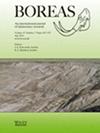Recent hummock establishment in the margin of a subarctic fen, Finnish Lapland
IF 2.4
3区 地球科学
Q2 GEOGRAPHY, PHYSICAL
引用次数: 0
Abstract
Northern fens, that host unique biota and form a remarkable carbon stock, are sensitive to changes in the moisture balance and, therefore, may be strongly affected by climatic fluctuations. However, long‐term monitoring and palaeoecological studies of fens are relatively rare and, as a result, their responses to past and current climatic fluctuations are poorly known. In this study, we examined the recent vegetation change as well as changes in testate amoeba communities in the mire margin of a subarctic fen in Finnish Lapland with four peat profiles. Testate amoebae were used as indicators of past fluctuations in water table depth. The vegetation showed a drastic shift from sedge‐dominated fen to Sphagnum‐dominated communities during the late 20th and the early 21st centuries. This shift was accompanied by a turnover in the testate amoeba community. Testate amoeba‐based water table reconstructions indicated recent drying. This may be due to the lowering of the water table either from accelerated Sphagnum increment or enhanced evaporation. The observed hummock establishment concurs with the documented hemisphere‐wide expansion trend of hummock communities in fens. This change may strengthen the carbon sink and storage capacity of these peatlands, which could be viewed as a welcome negative feedback process to the ongoing climate warming. However, the change also poses a threat to biodiversity since fens are not only species‐rich habitats but are also endangered ecosystems.芬兰拉普兰亚北极沼泽边缘最近形成的沼丘
北部沼泽地承载着独特的生物群落,形成了显著的碳储量,对水分平衡的变化非常敏感,因此可能会受到气候波动的强烈影响。然而,对沼泽地的长期监测和古生态学研究相对较少,因此,人们对沼泽地对过去和当前气候波动的反应知之甚少。在这项研究中,我们通过四个泥炭剖面考察了芬兰拉普兰亚北极沼泽沼泽边缘近期植被的变化以及睾丸变形虫群落的变化。睾丸变形虫被用作地下水位过去波动的指标。在 20 世纪末和 21 世纪初,植被从以莎草为主的沼泽急剧转变为以泥炭藓为主的群落。伴随这一转变的是睾丸变形虫群落的更替。以睾丸变形虫为基础的地下水位重建表明最近出现了干燥。这可能是由于泥炭藓加速增殖或蒸发加剧导致地下水位下降。所观察到的腐殖层的建立与所记录的沼泽中腐殖层群落在全半球范围内的扩展趋势一致。这种变化可能会加强这些泥炭地的碳汇和碳储存能力,这可以被视为对当前气候变暖的一个可喜的负反馈过程。然而,这种变化也对生物多样性构成威胁,因为沼泽不仅是物种丰富的栖息地,也是濒危生态系统。
本文章由计算机程序翻译,如有差异,请以英文原文为准。
求助全文
约1分钟内获得全文
求助全文
来源期刊

Boreas
地学-地球科学综合
CiteScore
5.90
自引率
4.50%
发文量
36
审稿时长
>12 weeks
期刊介绍:
Boreas has been published since 1972. Articles of wide international interest from all branches of Quaternary research are published. Biological as well as non-biological aspects of the Quaternary environment, in both glaciated and non-glaciated areas, are dealt with: Climate, shore displacement, glacial features, landforms, sediments, organisms and their habitat, and stratigraphical and chronological relationships.
Anticipated international interest, at least within a continent or a considerable part of it, is a main criterion for the acceptance of papers. Besides articles, short items like discussion contributions and book reviews are published.
 求助内容:
求助内容: 应助结果提醒方式:
应助结果提醒方式:


